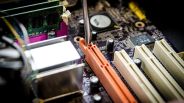Scientists have developed an algorithm that can fasten the process, improve the efficiency and reduce the costs of drug development. The robotic system holds much potential in transforming the drug discovery process.
Drug discovery is a tedious, lengthy process that involves numerous laboratory tests to analyze the effects of various drugs on different target proteins. Determining the target proteins alone is a big task. Looking for the right drug to induce the right effect is even more enormous. To date, scientists need to come up with a hypothetical guess to pick the right experiment to conduct.
Now, a team of scientists from Carnegie Mellon University (CMU) in the U.S. created a robotic system that can do the mounting tasks. The scientists have utilized 96 cells and 96 drugs that amount to 9,216 potential experiments.
The team has developed an algorithm that scanned all 96 cells and determined the phenotypes or protein location in each one. The individual effects of all 96 drugs were also recorded. With each round, the AI was able to identify patterns in the phenotypes.
The AI "learned" about the cells, drugs and their interactions after each test run. It grouped similar images together and soon it was able to pinpoint new phenotypes without any help from the research team. Out of the original 9,216 potential experiments, the AI conducted 2,697 experiments in just 30 rounds. The gathered data was used to create a predictive model that can guess the results of other potential experiments that were not measured.
"[The algorithm] was able to learn a 92 percent accurate model for how the 96 drugs affected the 96 proteins," said the research team. This feat was achieved by pursuing only 29 percent of nearly 10,000 possible combinations. The robotic system was able to reduce the number of necessary drug experiments by 70 percent.
"Our work has shown that doing a series of experiments under the control of a machine learner is feasible even when the set of outcomes is unknown. We also demonstrated the possibility of active learning when the robot is unable to follow a decision tree," said senior author Robert F. Murphy who led the scientific team. Murphy is CMU's head of Computational Biology Department.
The findings were published in the journal eLife on Feb. 3.
Photo: Taki Steve | Flickr
ⓒ 2025 TECHTIMES.com All rights reserved. Do not reproduce without permission.




